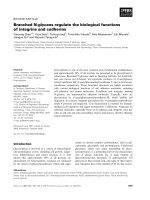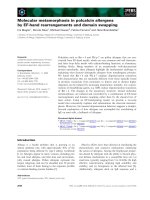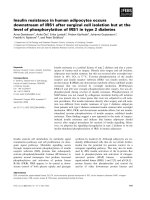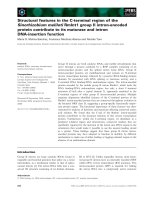Báo cáo khoa học: "Summer eczema in exported Icelandic horses: influence of environmental and genetic factors" doc
Bạn đang xem bản rút gọn của tài liệu. Xem và tải ngay bản đầy đủ của tài liệu tại đây (212.89 KB, 4 trang )
BioMed Central
Page 1 of 4
(page number not for citation purposes)
Acta Veterinaria Scandinavica
Open Access
Research
Summer eczema in exported Icelandic horses: influence of
environmental and genetic factors
Sigríður Björnsdóttir*
1
, Jakobína Sigvaldadóttir
1
, Hans Broström
2
,
Birgitte Langvad
3
and Ágúst Sigurðsson
4
Address:
1
Icelandic Veterinary Services, Dept Holar, 551 Saudarkrokur, Iceland,
2
Dept Clin Sci, Sect Medicine and Surgery, Box 7018, SLU, SE-750
07 Uppsala, Sweden,
3
Valbyvej 42, 3200 Helsinge, Danmark and
4
The Icelandic Farmers Association, Hagatorgi 1, Reykjavík, Iceland
Email: Sigríður Björnsdóttir* - ; Jakobína Sigvaldadóttir - ; Hans Broström - ;
Birgitte Langvad - ; Ágúst Sigurðsson -
* Corresponding author
Abstract
A cross sectional study was designed to estimate the prevalence of summer eczema (a chronic,
recurrent seasonal dermatitis) in exported Icelandic horses and the influence of environmental and
genetic factors on the development of the disease.
Among 330 horses, which had been exported to Germany, Denmark and Sweden, 114 (34.5%)
were found to have clinical signs of summer eczema. The prevalence was highest 2 years after
export and the exposure to the biting midges Culicoides spp., was found to be the main risk factor
for developing the disease. Genetic influence on the sensitivity for the disease was not established.
It was concluded that exported Icelandic horses are predisposed for summer dermatitis and the
fact that they are not introduced to the antigens of the biting midges early in live, due to it's absence
in Iceland, is likely to explain the high prevalence of the disease after export.
Introduction
Summer eczema (SE) also known as equine insect bite
hypersensitivity or sweet itch, is a chronic, recurrent sea-
sonal dermatitis of horses caused by an allergic reaction to
the bite of Culicoides ssp midges [1-4]. The symptoms
include intense pruritus, self-excoriation resulting in open
wounds and secondary infections and are usually local-
ized to the mane, tail and withers [5]. Most breeds of
horses can be affected although the prevalence seems to
vary considerably between countries and different regions
within countries [5-10].
Due to the absence of the biting midges in Iceland [11], SE
is an unknown disease in the native horse population. The
disease is, however, a well-known problem in Icelandic
horses that have been exported from Iceland and Icelandic
horses born abroad. In an epidemiological study based on
a questionnaire sent to all registered owners of Icelandic
horses in Sweden, the prevalence was found to be 16.6%.
It was significantly higher among horses imported from
Iceland, 26.2%, compared to Icelandic horses born in
Sweden, 6.7% [5]. Similar results were found for Icelandic
horses in Norway, also based on a questionnaire sent to
the owners [12]. The overall prevalence was 17.6%, higher
Published: 26 May 2006
Acta Veterinaria Scandinavica 2006, 48:3 doi:10.1186/1751-0147-48-3
Received: 11 April 2006
Accepted: 26 May 2006
This article is available from: />© 2006 Björnsdóttir et al; licensee BioMed Central Ltd.
This is an Open Access article distributed under the terms of the Creative Commons Attribution License ( />),
which permits unrestricted use, distribution, and reproduction in any medium, provided the original work is properly cited.
Acta Veterinaria Scandinavica 2006, 48:3 />Page 2 of 4
(page number not for citation purposes)
for imported horses 26.9% compared to native-born
horses, 8.2%.
The aim of the present study was to describe the clinical
signs, estimate the prevalence and the influence of envi-
ronmental and genetic factors on the development of
summer eczema in exported Icelandic horses.
Materials and methods
Study design
A cross sectional study was designed to assess the preva-
lence, hereditariness and risk factors of SE in Icelandic
horses that had been exported to Germany, Denmark and
Sweden. Offspring of 17 sires, with the highest number of
exported offspring in the previous five years and repre-
senting all the major bloodlines of the Icelandic horses
(information from the Icelandic Breeding Association)
were selected for the study. Owners of Icelandic horses, in
the three countries, were informed about the study in
local horse magazines and requested to participate with
their horses. For logistical reasons, owners of big horse
farms were contacted directly and their farms used as
meeting points for the study.
The responding owners were visited in the years 1997–8,
and all horses, fulfilling the selection criteria, were exam-
ined clinically by the same veterinarian (S.J.). Presence of
skin lesions compatible with SE was recorded and the
characteristics and distribution of the lesions were
described. Blood samples were collected and DNA
extracted from whole blood leukocytes for confirming the
paternity and for further genetic studies in the future.
The owners were interviewed about the age of the horse at
examination, age at export and age at first signs of SE.
Information was obtained about environmental factors
such as stabling, type of pasture, lee (wind) at pasture,
moisture of pasture and distance from lake or running
water. The owners were also asked if the area was a known
inhabitation of Culicoides spp. or if summer eczema was a
known problem for horses in the area.
Variables
Dichotomous variables included: a) Housing (0: never in
a stable or shelter, 1: shelter at pasture or in stable from
the evenings to the mornings), b) Type of pasture (0: not
cultivated, natural unploughed grass land, 1: cultivated
ground or mixture), c) Moisture of pasture (0: dry to
medium dry, 1: medium wet to swamp), d) Lee at pasture
(0: mostly moderate to hard winds, 1: mostly mild to
moderate winds), e) Water in the neighborhood of pas-
ture (0: no open water within 1 km, 1: open water in the
area, f) Known habitat of Culicoides spp. or known summer
eczema area (0: no, 1: yes). Categorical variables included:
gender, sire and country of examination and continuous
variables included: age, age at export and years from
export.
Statistical methods
The association between the dichotomous dependent var-
iable of the presence of SE and the potential risk factors
was first screened using univariate logistic regression. Fac-
tors with P values < 0.05 were then examined further by
using forward stepwise multivariate logistic regression
analysis. An attempt was made to estimate the heritability
of SE with REML type methods both applying a linear ani-
mal model [13] and a non-linear sire model [14].
Results
In total 330 horses were examined for summer eczema,
170 in Germany, 82 in Denmark and 75 in Sweden. The
age of the horses ranged from 1 to 25 years with the mean
of 10.3 years. The distribution of gender was 58% mares,
31% geldings and 11% stallions. The age at export was
known for 262 of the horses (79.4%) and ranged from
few months to 16 years. The mean age at export was 3.1
years. Time since export was known for 312 of the horses
(94.5%) ranging from few months to 22 years with the
mean of 4.7 years.
Clinical signs of SE were found in 114 horses or 34.5%.
Information about the time of onset of the disease after
export was available for 49 of the affected horses and
ranged from 1 to 8 years. In most cases the onset of SE was
first detected 2 years after export (mean 2.4 years) (Table
1). For horses exported for more than two years prior to
the study (n = 213), SE was diagnosed in 49.5%.
The characteristics and distribution of the skin lesions was
described for 43 of the horses. The most common signs
were itching (100%), thickening of the skin (100%), alo-
pecia (97%), excoriation (91%), scale (89%) and wounds
(71%). Secondary infections were not described. The
symptoms were recorded at the mane (93%), tail (72%),
abdomen (30%), head (21%), side (9%) and chest (5%).
Risk factors
The univariate logistic regression analysis revealed a sig-
nificant association between the presence of SE and the
variables: age, years from export, known habitat of Culi-
Table 1: Number of years from export until the first clinical signs
of SE were detected in 49 Icelandic horses.
Years from export 012345678
New cases of SE 7 8 168 43111
Prevalence of SE % 1416331686222
Acta Veterinaria Scandinavica 2006, 48:3 />Page 3 of 4
(page number not for citation purposes)
coides spp., cultivation of pasture, moisture of pasture, lee
at pasture and open water in the neighborhood of pasture
(Table 2). The five last variables are all supposed to reflect
the same risk factor: the exposure to the biting insect Culi-
coides spp. The final multivariate model (Table 3) includes
the variables: years from export, moisture of pasture and
lee at pasture.
The estimated heritability was not significantly different
from zero.
Discussion
At the time of the examination a central database did not
exist for Icelandic horses in Europe prohibiting selection
of a random material from the population. The central
database [15] introduced in 2000 has improved the avail-
ability of information about the population. The wide dis-
tribution of exported Icelandic horses in Europe, where
they are kept in different environments and where the
management is variable, make a complete epidemiologi-
cal study difficult to perform. The owners are, however,
well aware about the disease and were willing to partici-
pate with their horses in the survey. Emphasis was made
on visiting large horse farms where all horses fulfilling the
criteria were examined. On these farms, horses were kept
from many owners who were not all able to be there per-
sonally at the time of the examination. This is the main
reason for some missing data of the questionnaire.
The prevalence was higher in the present study (34.5%)
compared to results earlier reported from Sweden and
Norway [5,12]. The main reason is that only horses
exported from Iceland were included in our study. Clini-
cal examination of the horses might also have contributed
to higher prevalence compared with studies based on
questionnaires sent to the owners as mild symptoms of
SE, probably overseen by the owners, were revealed. There
is also a risk that the current material might be biased as
owners of horses with SE or living on areas where SE is a
problem were probably more willing to participate in the
study.
Although comparable figures are not available for other
breeds, the high prevalence found in this study indicates
that Icelandic horses that have been exported to the conti-
nent of Europe are predisposed for SE. The export of
horses is followed by great environmental changes includ-
ing different weather conditions and introduction to new
microbes and insects. Together with stress, due to the
transport, these changes seem to influence the immune
system negatively.
Table 3: Final model based on multivariate logistic regression of
possible risk factors of SE for for 275 Icelandic horses.
Risk factors OR CI (95%) p value
Years from export* 1,097 1,016 – 1,183 0,017
Moisture at pasture 1,860 1,023 – 3,366 0,040
Lee at pasture 2,278 1,155 – 4,491 0,017
* Odds-Ratio (OR) and 95% confidence intervals (CI) for each year
Table 2:
Risk factors/
variables
Information rate N n (%) p
Age 84,2 0,000
Age of export 79,4 0,200
Years from export 94,5 0,002
Gender 95,8 0,671
Geldings 99 34 (34)
Mares 183 62 (34)
Stallions 34 10 (29)
Sire 100 0,696
0 123 43 (35)
1102(20)
2195(26)
3199(50)
4103(30)
5238(35)
6108(80)
72810(36)
883(38)
991(11)
10 4 1 (25)
11 8 3 (38)
12 14 6 (43)
13 9 0 (0)
14 13 2 (15)
15 4 1 (25)
16 5 2 (40)
17 15 7 (47)
Country of examination 100 0,182
Sweden 75 25 (33)
Danmark 84 24 (29)
Germany 171 65 (38)
Culicoides inhabition 82,1 0,000
No 147 34 (23)
Yes 124 57 (46)
Housing 82,7 0,161
No 132 39 (30)
Yes 141 53 (38)
Cultivation of pasture 83.0 0,025
No 110 46 (42)
Yes 164 47 (29)
Moisture at pasture 82,1 0,000
No 156 37 (24)
Yes 115 52 (45)
Lee at pasture 82,1 0,000
No 94 17 (18)
Yes 177 72 (41)
Open water at pasture 82,4 0,01
No 143 38 (27)
Yes 129 52 (40)
Publish with Bio Med Central and every
scientist can read your work free of charge
"BioMed Central will be the most significant development for
disseminating the results of biomedical research in our lifetime."
Sir Paul Nurse, Cancer Research UK
Your research papers will be:
available free of charge to the entire biomedical community
peer reviewed and published immediately upon acceptance
cited in PubMed and archived on PubMed Central
yours — you keep the copyright
Submit your manuscript here:
/>BioMedcentral
Acta Veterinaria Scandinavica 2006, 48:3 />Page 4 of 4
(page number not for citation purposes)
Number of years after export influenced the prevalence of
the disease. The prevalence in this study was highest 2
years after export, which gives one year shorter sensitiza-
tion period than earlier reported [12]. The different meth-
ods used in these studies can explain this as earlier stages
of the disease might have been detected by clinical exam-
ination compared to questionnaire sent to the owners.
Age at export did on the other hand not influence the
prevalence of SE and neither did country of import or gen-
der.
The exposure to the biting insect Culicoides spp., seems to
be the main risk factor for developing SE after export. For
horses that were exported for more than two years ago and
living in a known habitat of the responsible insect, the
prevalence of SE was as high as 54%. The variables, mois-
ture of pasture and lee at pasture seem to be basic factors
for the inhabitation of the insect at pasture. The fact that
Icelandic horses are not introduced to their antigens in
early live is likely to explain the high prevalence in
exported horses. In laboratory animals it has been shown
that allergic IgE responses to certain antigens can be spe-
cifically suppressed by passive transfer of maternal immu-
nity via colostrum from immunised mothers [16,17].
There were no evidences of sire effect on the prevalence of
the disease in this material and the estimated heritability
was not different from zero. The genetic influence on the
disease has, however, not been ruled out. Due to the great
influence of environmental factors, the material must be
regarded as far too small for detecting the genetic effects
[18].
The description of the clinical signs was in agreement with
earlier reports [5,19].
According to current knowledge, the prevention of the dis-
ease must be based on avoidance of the biting midges,
keeping the horses on windy, dry pasture, stabling the
horses when the midges are most active or using eczema
blankets.
Acknowledgements
The authors want to thank the sponsors of the study: The Icelandic
Research Council, The Marketing Committee of the Icelandic Horse and
Agria Animal Insurance Company.
References
1. Quinn PJ, Baker KP, Morrow AN: Sweet itch: responses of clini-
cally normal and affected horses to intradermal challenge
with extracts of biting insects. Equine Vet J 1983, 15:266-272.
2. Larsen HJ, Bakke SH, Mehl R: Intradermal challenge of Icelandic
horses in Norway and Iceland with extracts of Culicoides spp.
Acta vet scand 1988, 29:311-314.
3. Halldordottir S, Larsen HJ: Intradermal challange of Icelandic
horses with extracts of four species of the genus Culicoides.
Res in Vet Science 1989, 47:283-287.
4. Wilson AD, Harwood LJ, Björnsdottir S, Marti E, Day MJ: Detection
of IgG and IgE serum antibodies to Culicoides salivary gland
antigens in horses with insect dermal hypersensitivity (sweet
itch). Equine Vet J 2001, 33(7):707-713.
5. Broström H, Troedsson M, Larsson Å: Allergic drematitis (sweet
itch) of Icelandic horses in Sweden: An epidemiological
study. Equine Vet J 2001, 19(3):229-236.
6. Littlewood JD: Incidence of recurrent pruritus ("sweet itch")
in Brittish and German shire horses. Vet Rec 1998, 142:66-67.
7. McCaig J: A survey to establish the incidence of sweet itch in
ponies in the United Kingdom. Vet Rec 1973, 93:444-446.
8. Braverman Y, Ungar-Waron H, Frith K, Adler H, Danieli Y, Baker KP,
Quinn PJ: Epidemiological and immunological studies of
sweet itch in horses in Israel. Vet Rec 1983, 112:521-524.
9. Andersson GS, Belton P, Kleider N: The hypersensitivity of
horses to Culicoides bites in Brittish Columbia. Can Vet J 1988,
29:718-723.
10. Riek RF: Studies on allergic dermatitis (Queensland Itch) of
the horse. 1. Description, distribution, symptoms and
pathology. Aust Vet J 1953, 29:177-184.
11. Illies J: Limnofanuna europaea Gustav Fisher Verlag, Stuttgart, New
York; 1978:532.
12. Halldordottir S, Larsen HJ: An epidemiological study of summer
eczema in Icelandic horses in Norway. Equine vet J 1991,
23:296-299.
13. Boldman KG, Kriese LA, Van Vleck LD, Van Tassell CP, Kachman SD:
A manual for use of MTDFREML. A set of programs to
obtain estimates of variances and covariances. ARS-USDE, Clay
center, NE 1995:114.
14. Misztal I, Gianola D, Foulley JL: Computing aspects of a nonlinear
method of sire evaluation for categorical data. J Dairy Science
1989, 72:1557.
15. [
].
16. Jarrett EEE, Hall E: Selective suppression of IgE responsiveness
by maternal influence. Nature 1979, 280:145-147.
17. Jarrett EEE, Hall E: Regulation of ongoing IgE antibody response
with minute doses of antigen. Eur J Immunol 1981, 11:520-525.
18. Strothmann A: Beitrag zum Sommerekzem (Allergische Der-
matitis) der Islandpferde. Litteraturstudie und eigene
Untersuchungen. Thesis Hannover 1982.
19. Barbet J: Culicoides hypersensitivity. Section 16, Skin dis-
eases. In Current therapy in equine medicine Edited by: Robinson NE.
WB Saunders company, Harcourt Brace Jovanovich, Inc. Philadelphia,
Pennsylvania, USA; 1992.









